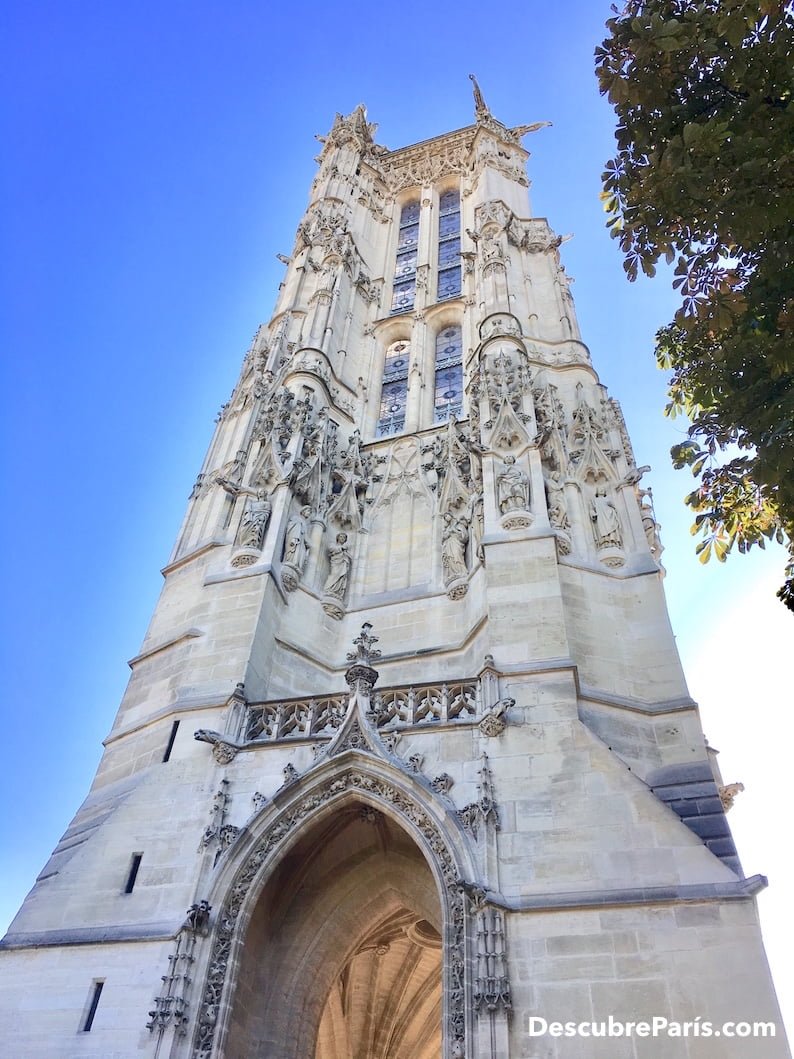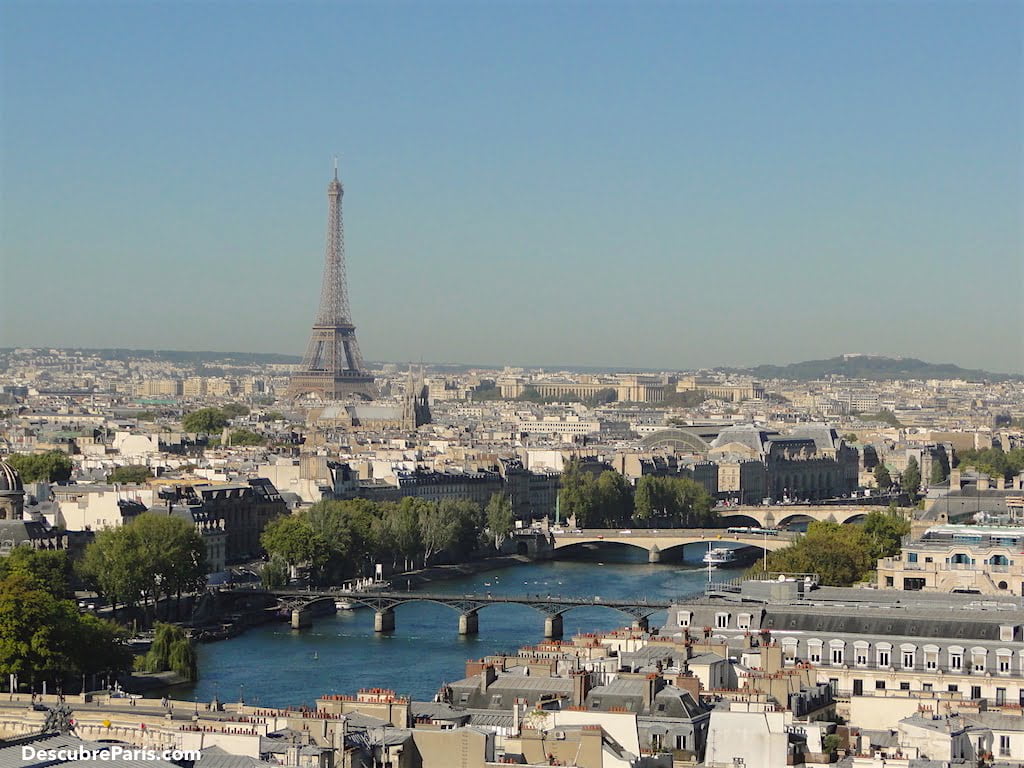
Many people, tourists and Parisians alike, do not know the history of La Tour Saint-Jacques (St. James Tower in English). Perhaps because it only reopened in 2009 after a restoration that took almost 10 years. Even I, who have walked by it many times, only knew that it was the vestige of an old church.
Well, one of my resolutions was to discover the lonely Tour Saint-Jaques, so I’ll be sharing a summary of its history and what you should know if you want to visit it, plus a couple of fun facts as per usual!
HISTORY OF THE TOUR SAINT-JAQUES

To understand the history of the Tour Saint-Jacques, we must go back to the Paris that was surrounded by a medieval wall. The Company of Butchers (yes, nothing glamorous but very powerful, like the Company of Merchants that founded the Hôtel de Ville), settled outside the great market that was Châtelet. It is said that they had a lot of money and had a church built in honor of St. James the Great, on the remains of a temple found there and dating far back (there are even legends that speak of the time of Charlemagne).
Years later, the church was bought and dismantled on condition that the tower was preserved. It was later acquired by an industrialist to create a foundry for lead bullets for hunting. The height of the tower was sufficient for the falling lead drops to cool when they reached the bottom (50 meters high).
After two fires, the Tower was bought by the Mayor of Paris, and around 1852, when the excavation works of the Rue de Rivoli began, it was decided this place would be restored. This was largely financed by Nicolas Flamel, a French bourgeois millionaire, and even has his initials on the stained glass windows, as well as those of the architect Théodore Ballu.
The Tour Saint-Jacques bell tower is thus the only vestige of the Saint-Jacques-La-Boucherie church, which was built in honor of Saint James the Great. Its current decoration, in flamboyant Gothic style, is the result of another restoration process initiated by Napoleon III.
It was finally restored again between 2001 and 2009 and is part of the UNESCO World Heritage and the “Camino de Compostela”.
A TOWER FULL OF LEGENDS

Two legends caught my attention about this tower. The first is that it is said that during the Revolution the Saint-Jacques Tower was not demolished because Blaise Pascal (the famous mathematician and physicist) had resumed there his experiments on atmospheric pressure. This legend is false, because Pascal carried out these experiments in the Saint-Jacques-du-Haut-Pas church located in the 5th arrondissement of Paris.

The other is that Nicolas Flamel (who financed the restoration of the tower along with his wife, and of whom there is a representation in the north portal), was said to be an alchemist, who turned metals into gold having found the Philosopher’s Stone. Harry Potter fans will surely be interested! Well, it turns out that Flamel was very wealthy because he had had a prosperous career and because he married a wealthy widow. Certainly an interesting way to turn metal into gold.
HOW TO VISIT THE TOUR SAINT-JACQUES

Currently the Ville de Paris has handed over the organization of the tours of the Tour Saint-Jacques to the agency “Des Mots et des Arts”, a Parisian agency, which organizes workshops, guided tours and thematic tours (very interesting for history fans).
The tours are mainly in French, but also in English. If you feel like it, and do not have knee problems, heart or claustrophobia, you can easily book your visit on the website of the agency in charge and access this unique place. Entry is only available during the summer starting at 10€ and it is strictly forbidden for children under 10 years old and babies.
You must book and pay online (the groups are small), the day of the visit arrive very punctual at the reception place (a small blue booth at the side of the park), the attendants will verify your registration, give you a ticket, and then the visit begins.
The introduction is at the base of the tower, and then the ascent beginsThe introduction is at the base of the tower, and then you start the ascent to a first level (50 steps to warm up your knees), then 70 more and finally the rest, for a total of 300 steps (it’s like climbing the Arc de Triomphe).
The view of Paris will leave you speechless.

Fun Fact 1:
The Place de la Tour Saint-Jacques was the first endowed and equipped square in Paris and was created in 1856 after the acquisition of the land by the City of Paris. This was part of the great transformations carried out in the city by Baron Haussmann, which sought to improve hygiene and circulation in the city center.
To get to the Place de la Tour Saint-Jacques (Square de la Tour Saint-Jacques) you can take Metro Lines 1, 4, 7, and 11 and get off at Châtelet (and walk 4 minutes) or Metro Lines 1 and 11 to Hôtel De Ville, and walk on Rue de Rivoli until you meet the square and the tower.
Fun Fact 2:
At the top of the Tower, you’ll find gargoyles, a large statue of St. James (standing) and 4 allegorical representations: The Lion (St. Mark), the Bull (St. Luke), the Angel (St. Matthew) and the Eagle (St. John). These statues are approximately 4 meters high and are accompanied by 18 statues of saints that decorate the sides of the tower.
So you know, if you come in summer and until November 3, you can take a guided tour of the Tour Saint-Jacques. Between 10:00 a.m. and 17h00 (5 p.m.) from Friday to Sunday. Tickets are available on the website Des Mots et Des Arts or directly at the ticket window (a little blue house on one side of the park). If you don’t want to worry about anything, you can ask us to design a personalized guide, where we can create an itinerary that fits your needs!
Paris is waiting for you.
A bientôt!

